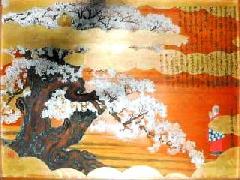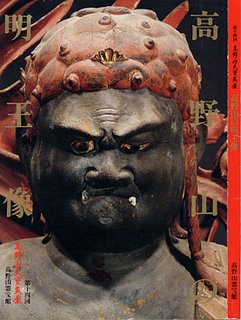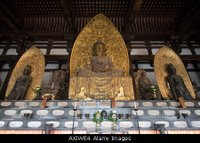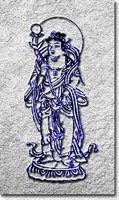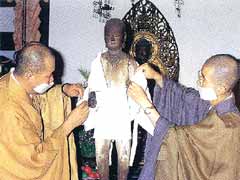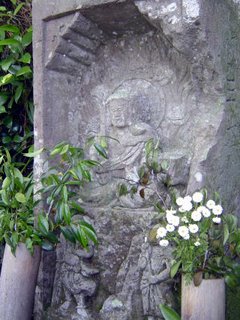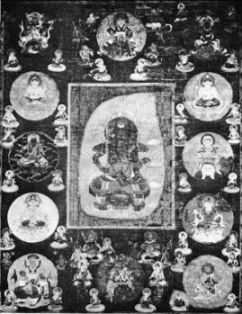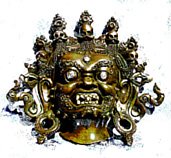:::::::::::::::::::::::::::::::::::::::::::::::::::::::::::::::::::::::::::::::::::::::::::::::::::::
Monju Bosatsu 文殊菩薩 Manjushri - Mañjuśrī

A disciple of the Historical Buddha, Monju represents wisdom, intelligence and willpower. In artwork, Monju is often portrayed with a sutra in his left hand (a symbol of wisdom) and a sword in his right (to cut through illusion), but not always.
Sometimes Monju carries a lotus flower and is riding a Shishi (mythical lion).
Monju Bosatsu - Japanese Buddhist Deity of Wisdom and Education
Read all the Details from Mark Schumacher.
:::::::::::::::::::::::::::::::::::::::::::::::::::::::::::::::::::::::::::::::::::::::::::::::::::::
. Monju Bosatsu Ceremony, Monju-E 文殊会
kigo for mid-summer
Ama no Hashidate Festival, Ama no Hashidate Matsuri
天の橋立祭
.................................................................................
kigo for late spring
Koofukuji Monju e 興福寺文殊会 (こうふくじもんじゅえ)
ceremony for Monju Bosatsu at temple Kofuku-Ji
April 25
. Koofukuji 興福寺 Temple Kofuku-Ji Nara .
:::::::::::::::::::::::::::::::::::::::::::::::::::::::::::::::::::::::::::::::::::::::::::::::::::::
Manjuvajra Mandala
Manjuvajra (Monju) carries a blue lotus, utpala, in his upper hand. The central hands are crossed in front of his chest, symbolizing the union with his female deva.
Manjushri is known to live in the Paradise of the Five-Peak Mountain (Wu-tai-shan, China)or in the Vimla (Yuima) paradise in the East. In this sculpture, he sits in a temple-like building, surrounded by five more temple towers around his head. This formation symbolizes the four heavenly directions with the center (pancha sikha, five peaks, five crests).
The figure of Monju is closely related to the number FIVE. We have statues with five hairknots, five signs or five companions.

Pala period (ca. 700–1200), 11th century
Bangladesh or India (West Bengal)
Black stone; H. 50 3/4 in. (128.9 cm)
Bequest of Cora Timken Burnett, 1956
Copyright © 2000–2006 The Metropolitan Museum of Art.
http://www.metmuseum.org/toah/ho/07/ssn/hob_57.51.6.htm
:::::::::::::::::::::::::::::::::::::::::::::::::::::::::::::::::::::::::::::::::::::::::::::::::::::
From Outcasts to Emperors:
Shingon Ritsu and the Mañjuśrī Cult in Medieval Japan
David Quinter, University of Alberta, Canada
In From Outcasts to Emperors, David Quinter illuminates the Shingon Ritsu movement founded by the charismatic monk Eison (1201–90) at Saidaiji in Nara, Japan. The book’s focus on Eison and his disciples’ involvement in the cult of Mañjuśrī Bodhisattva reveals their innovative synthesis of Shingon esotericism, Buddhist discipline (Ritsu; Sk. vinaya), icon and temple construction, and social welfare activities as the cult embraced a spectrum of supporters, from outcasts to warrior and imperial rulers. In so doing, the book redresses typical portrayals of “Kamakura Buddhism” that cast Eison and other Nara Buddhist leaders merely as conservative reformers, rather than creative innovators, amid the dynamic religious and social changes of medieval Japan.

- source : www.brill.com/products/book -
:::::::::::::::::::::::::::::::::::::::::::::::::::::::::::::::::::::::::::::::::::::::::::::::::::::
食逃や蚊蚤もちえの文珠堂
kui nige ya ka nomi mo chie no monjudoo
eat and run, the wisdom
of mosquitoes and fleas...
Wisdom Buddha's temple
Tr. David Lanoue
Kobayashi Issa 小林一茶
. Cultural keywords and kigo used by Issa .
There are various halls with this name in Japan.

:::::::::::::::::::::::::::::::::::::::::::::::::::::::::::::::::::::::::::::::::::::::::::::::::::::
Utpala, the blossom of the blue lotus (Nymphaea caerulea)
..... INDIA SAIJIKI .....: Lotus (padma)
:::::::::::::::::::::::::::::::::::::::::::::::::::::::::::::::::::::::::::::::::::::::::::::::::::::
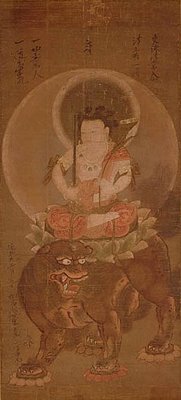
© Nara National Museum
Monju Bosatsu
Monju (Manjushri)
"Glückhafter Jüngling." Lautmalerische Abkürzung für "Monjushiri".
Stellt Wissen, Weisheit und Erleuchtung dar.
Nach dem Tode des Shakyamuni in Indien geborener Mensch, durch Askese zum Bosatsu geworden. Besonders in Tibet, Nordchina und der Mongolei (Mandschuria > Manjuria > Monju) verehrt.
Er schenkt Weisheit in allen Lebenslagen, nicht nur reine Intelligenz.
Beliebt auch in der Zen-Sekte, da er das aus der Erleuchtung kommende Wissen verkörpert. Häufig in der Zazen-Übungshalle für junge Zen-Mönche aufgestellt. Ein typisches japanisches Sprichwort lautet: Wenn drei Menschen zusammenkommen, sind sie so klug wie Monju (sannin yoreba, Monju no chie 三人寄れば文殊の知恵).
Die Geschichte über seinen religiösen Disput mit Vimalakirti (Yuima 維摩 ) wird im Sutra Yuimakyoo 維摩 (ゆいま) 経 beschrieben.
Rechts im Westen einer Shaka-Dreiergruppe, zusammen mit Fugen Bosatsu.
Ikonografie:
Mit Schwert in der rechten und Sutrarolle in der linken Hand als Symbole höchster Weisheit und Erkenntnis.
In Zen-Klöstern oft in Priestergestalt in Meditationshaltung, mit Sutrarolle, Sutraschatulle oder Lotusblüte.
Im esoterischen Buddhismus seit der Heian-Zeit auf einem Lotussockel auf einem Löwen reitend (Monju Kishizoo 文殊騎士像).
Auch mit Asketengewand, unter dem sich eine chinesische Rüstung befindet.
Im esoterischen Buddhismus gibt es vier verschiedene Darstellun~gen eines Monju:
Je nach der Zahl der Buchstaben seines Mantra - eins, fünf, sechs oder acht, hat die Figur entsprechend viele Haarknoten und trägt bestimmte Gegenstände in den Händen.
Monju mit einem Zeichen (Ichiji Monju 一字文殊): linke Hand - wunscherfüllendes Juwel, rechte Hand - Weidenzweig.
Monju mit fünf Zeichen (Goji Monju 五字文殊): linke Hand - grüne Lotusblüte, auf der eine Sutraschatulle liegt, rechte Hand - Diamant-Schwert (kongooken).
Auch als "Monju mit fünf Haarknoten" (Gokei Monju 五髻文殊 ) dargestellt.
Monju mit sechs Zeichen (Rokuji Monju): linke Hand - zur Brust erhoben, Handfläche nach oben, rechte Hand - Geste des Rades der Lehre.
. Rokuji 六字 the power of Six Words .
Monju mit acht Zeichen (Hachiji Monju): linke Hand - Donnerkeil auf einer Lotusblüte oder vor der Brust gehaltene Faust, Daumen und Zeigefinger berühren sich; rechte Hand: Schwert der Weisheit
Besondere Statuen:
Monju über das Meer kommend (Tokai Monju 渡海文殊)
Monju auf einem Löwen sitzend; der Löwe steht auf Wolken und durchquert das Meer auf dem Weg nach dem Berg Wutai in China. In Japan auch über das Meer von China nach Japan interpretiert. Siehe auch die Monju-Fünfergruppe.
Monju-Fünfergruppe (Monju Gozonzoo 文殊五尊像)
Besonders in der Tendai-Sekte verehrt.
Der Mönch Ennin brachte in der Heian-Zeit ein Abbildung aus dem Kloster am Berg Wutai (Godaisan Monju) aus China mit nach Japan. Nach diesem Vorbild, eigentlich einem "Monju über das Meer kommend", entstand die Monju-Fünfergruppe.
Nach Hama sitzt Monju auf einem Lotussockel auf einem Löwen, neben ihm stehen Udenoo (Utenoo), Basuu Sennin, Zenzai Dooji und Buddhahari Sanzoo.
Nach Sasa wird Monju von vier Gefährten begleitet:
Sudhana (mit gefalteten Händen) weist den Weg, Udenoo in chinesischem Gewand hält die Zügel und zwei Heilige, Buddhahari (im Priestergewand) und Taisei-Roojin (mit einem Kopftuch) laufen nebenher.
Kindlicher Monju (Chigo Monju 稚児文殊)
Junger Mann oder kindliche Gestalt mit Schwert und langstieliger Lotusblüte in der Hand, auf einem Lotussockel auf einem Löwen oder direkt auf dem Löwen sitzend.
(Löwe versinnbildlicht Tapferkeit und Energie zur Ergänzung der Weisheit des Monju. Der Löwe hat oft ein grünes Fell.)
Haare in fünf Knoten (gokei 五髻) aufgebunden, als Symbol der fünf Zeichen des Monju-Mantras.
In dieser Gestalt auch in der Dreiergruppe mit Shaka Nyorai und Fugen Bosatsu.
Heiliger Priester Monju (Seisoo Monju, Soogyoo Monju 聖僧文殊)
Monju erscheint in der Figur eines alten Priesters in Klöstern, um die Lehre und die rechten Vorschriften für die Mönche zu erläutern. Statuen eines alten Priesters, meist in den Refektorien der Zen-Tempelklöster aufgestellt.
Der japanische Priester Gyooki (Gyoki 行基) soll eine Inkarnation des Monju sein.
Quoted from my book
Buddhastatuen (Buddhastatues) Who is Who,
Ein Wegweiser zur Ikonografie von japanischen Buddhastatuen
:::::::::::::::::::::::::::::::::::::::::::::::::::::::::::::::::::::::::::::::::::::::::::::::::::::
Monju Nuclear Power Plant
© More in the WIKIPEDIA !
[ . BACK to WORLDKIGO . TOP . ]
[ . BACK to DARUMA MUSEUM TOP . ]
:::::::::::::::::::::::::::::::::::::::::::::::::::::::::::::::::::::::::::::::::::::::::::::::::::::

